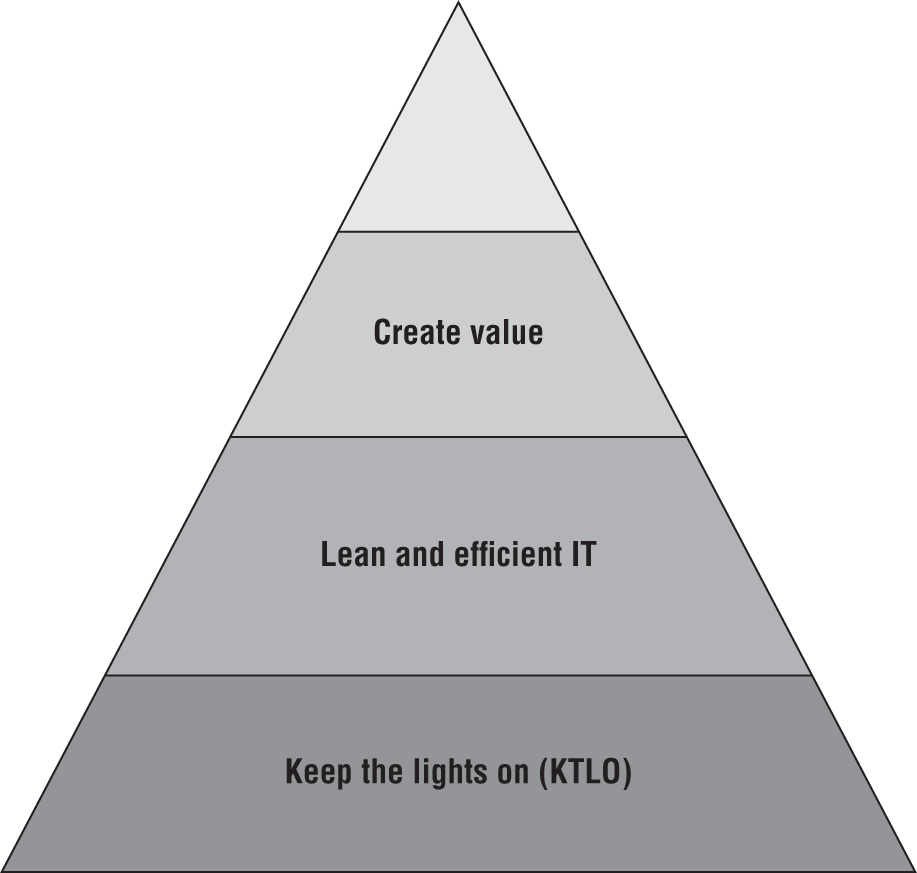8
Create Value
We are now at create value, the penultimate step of the Laudato Hierarchy of IT Needs, as seen in Figure 8.1. When you look at the list of strategic initiatives for your company, how many involve technology? 70 percent, 80 percent, 90 percent or more? Regardless of the industry, technology is at the center of almost all growth plans. Digital acceleration is driving these percentages even higher, spurred by the onset of the Covid-19 pandemic in 2020. Digital is transforming all sectors of the economy: manufacturing, media, entertainment, services, education, technology, healthcare, and retail. More and more, your efforts to create value will use and depend on technology in a variety of ways.

Figure 8.1 Laudato Hierarchy of IT Needs
© 2017 Andrew Laudato All Rights Reserved Hierarchy of IT Needs
That's good to know, but what does it mean to “create value?” In simple terms, creating business value means putting money in the bank. The more successful a company is, the more opportunities exist for its employees. Successful companies invest. Successful companies hire. Successful companies celebrate, and successful companies pay bonuses.
Business value comes from reducing costs, increasing revenue, enabling opportunities, and reducing risk.
Cost Reduction
Cost reduction projects are the easiest to measure, and therefore, the CFO's favorite. One of my favorite cost reduction tools is robotic process automation (RPA). RPA automates repetitive and mundane tasks by replacing work done by people with a software bot. For example, a bot can be programmed to log into a financial system, look up a past-due amount for a customer, format a personalized letter requesting payment, and email that letter directly to the customer. The first time I implemented RPA, I feared a backlash from the people doing the work manually. However, the opposite happened: because the bot replaced the most boring and thankless tasks, people were thrilled and thankful for RPA. Employees could now dedicate their time to more meaningful and fulfilling work.
Increase Revenues and Enable Opportunities
If a company’s bottom-line projects are the CFO's favorites, then top-line projects are the CEO's favorite. Projects that increase revenue have much more upside. The sky is the limit on top-line growth. A project that delivers new capabilities can put you ahead of the competition and increase your market share.
In the heat of the Coronavirus pandemic, Vitamin Shoppe commissioned a project to sell on Instacart. Instacart allows a customer to order products on their phone and have them delivered to their home the same day.
It took fewer than 90 days to implement the Instacart project with an exceptional ROI. This is IT at its best. If the tech team had been overwhelmed with KTLO, this project wouldn't have been sanctioned. If IT was over-budget on its capital expenditures, this project wouldn't have been sanctioned. If the prioritization process had been inflexible, this project wouldn't have been sanctioned. And if IT wasn't agile, the project wouldn't have been completed successfully and ahead of schedule.
Some IT projects are known as opportunity enablers. Although these types of projects don't have a direct ROI, they are necessary prerequisites to projects that do. A good example would be a content management system for your company's website. The content management system will enable the company to personalize experiences for its customers. Personalization is the real value creator, not the CMS system, itself, that enables personalization. Be sure to combine these types of projects when computing the project's true value.
Reduce Risk
Risk-reduction projects don't directly add to the top line or the bottom line, which sometimes makes them harder for CIOs to justify. Do not let this deter you. Reducing risk is an important undertaking, and projects that reduce risk are arguably more important than projects that fall into other categories. On the infrastructure side of the house, risk-reduction projects include upgrading to supported operating systems, building out redundancy for your network and servers, implementing cyber-security tools, and moving key workloads to the cloud. Applications also benefit from risk reduction efforts. Building fallback systems, modularizing code, and test automation are examples.
Major system failures are costly and embarrassing to companies and harm the reputation of the CIO. Don't wait to reduce risk until after an incident occurs. A mature enterprise risk-management process will help you identify areas of concern for your particular situation.